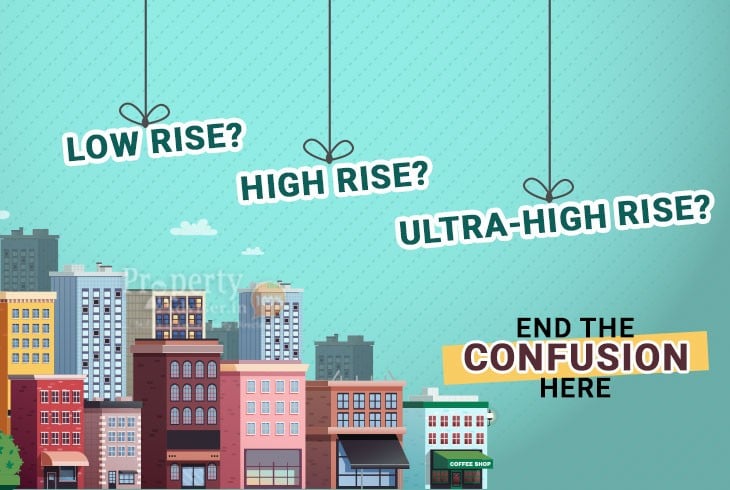A building is a structure constructed using wood frames or concrete and for a purpose, be it commercial use, residential, or industrial. If you are on the lookout for a property for self and words like low rise vs. mid-rise vs. high rise buildings are confusing you, then the content below is sure to clear a lot of your confusion.
A construction that has the following is a building:
- Foundations, plinths, walls, floors, roofs, chimneys, plumbing, etc.
- Verandahs, balconies, projections in the building which extend beyond its exterior
- Aside from the entire building, the components that are attached to a structure, such as a fence, boundary walls, or signboards
- Areas such as a swimming pool to use, water tanks to store water, etc.
Buildings can be categorized based on the number of stories constructed, like:
|
Building type |
Number of Floors |
Height (m) |
|
Low-rise building |
1-3 |
≤9 |
|
Multi-story building |
4-6 |
9-21 |
|
Middle-rise building |
7-9 |
21-30 |
|
Small high-rise building |
10-16 |
30-50 |
|
High-rise building |
17-40 |
50-100 |
|
Ultra-high-rise building |
>40 |
>100 |
1. Low-rise building: This type of construction is selected highly because of its versatility. One can build one building on the site or multiple facilities of the same height in the same location. The low-rise buildings are a little expensive to maintain as they don't sell at a higher rate. The demand for these buildings keeps varying year-over-year, depending on the area.
Masonry and timber are still the most used materials while building low-rise buildings. Plumbing systems should either be municipal water-distribution systems or from wells free from contamination.
2. Multi-storey building: A multi-story building is typically between four to six floors. The dominance of steel in the multi-storey commercial sector is based on tangible client-related benefits, including the ability to provide efficient circulation space, the site's influence, local access conditions on the construction process, and the integration of building services.
It is essential to ensure that the construction of these buildings can take the gravity load, as the building's rise is more than a typical low-rise building.
3. Middle-rise building or Mid-rise building: Buildings between 7 to 9 floors can be defined as the mid-rise buildings. These buildings generally have a right scale and relationship to the street. These buildings' walls are tall enough to maintain the residents' privacy but don't make them feel caged and restrict their access to fresh light and air.
The main characteristic of the middle rise buildings is that they are restricted in terms of their heights. Secondly, these buildings must fit within angular planes of 45 degrees from their front and back as per the predefined points.
4. Small high-rise buildings: Small high-rise buildings have between 10 to 16 floors. Developed countries all over the world are fast adopting the culture of the small high-rise buildings. This essential urban development tool aims at providing its residents with an enhanced and better way of living.
The most significant advantage of these buildings is that they are explicitly constructed, keeping in mind the residents' social, physical, and aesthetic needs. These buildings with their design and decorative comforts are fast gaining popularity as it promises a refined and enhanced way of existence.
5. High rise buildings: Looking for the right answer to what are tall rise buildings? Establishments with 17 to 40 floors can be defined as the high-rise buildings. These buildings, due to their height, make the presence of elevators compulsory.
The most standard feature of high-rise buildings is their steel structural frames and glass exterior sheathing. Since the foundation of high-rise buildings support weighty gravity loads, there is a tremendous use of concrete piers, piles, etc. that are dug deep into the ground. These buildings' primary purpose is to construct spaces that can withstand the lateral forces created by strong winds and earthquakes.
6. Ultra-high-rise buildings: There has been a tremendous rise in the demand of ultra-high-rise buildings in the last decade. Facilities that have more than 40 floors can be rightly defined as the ultra-high-rise buildings. Since these buildings consist of a large structure, they demand a solid foundation and construction.
These buildings are entirely dependent on technological innovations and engineering, and the construction is done, keeping in mind factors like safety, speed, and efficiency.
Terms like high rise vs. mid-rise vs. low rise can be very confusing when looking for the perfect option for yourself. There is no denying that when you are looking for a house, you are sure to be wondering about its many aspects such as what are high rise apartments, the differences between high rise vs. low rise buildings, etc. Keeping the purpose of utility in mind and understanding your needs, opt for the space that meets your and your family's requirements the best.












